What to Look for in Brisket for the PBC
Look for a 10-13 lb, USDA Choice or Prime graded, packer brisket.
Anything bigger will have issues fitting on the PBC without heavy trimming.
This brisket was 13.9 lbs and I trimmed it down to fit:
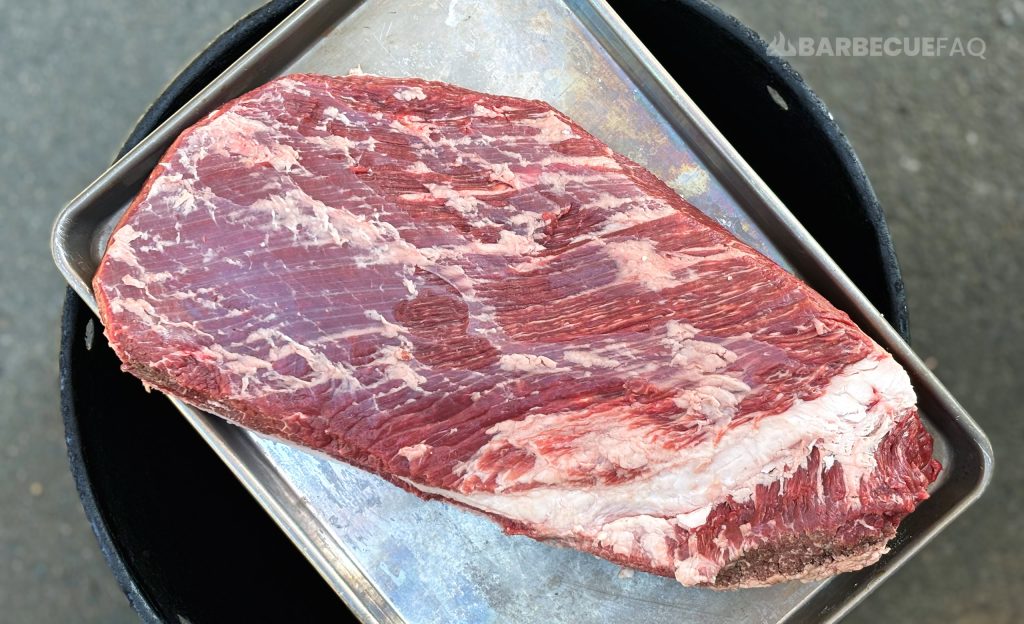
Trimming the Brisket for the PBC
I have an entire article that goes over my trimming process from start to finish. You can check out my trimming guide by clicking here.
When trimming, you want to have roughly a 1/4″ fat cap.
You also want to round off corners and remove excess hard fat that won’t render.
Apply Rub to the Brisket
For this recipe I used a brisket rub by Steve Gow from Smoke Trails BBQ.
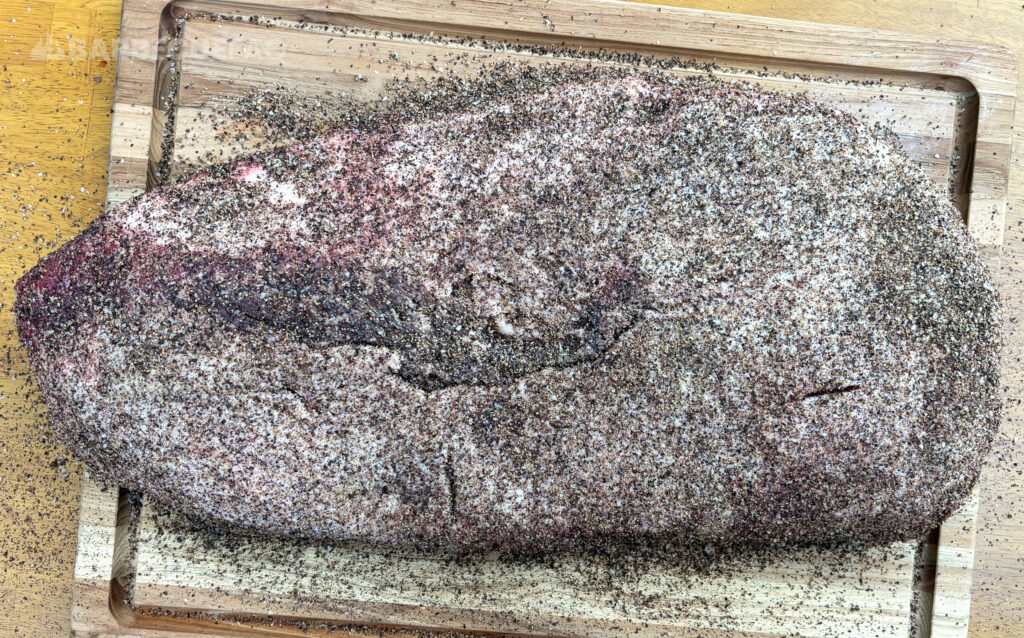
If you don’t want to purchase that, use your favorite brisket rub or use the following:
- 1 Tablespoon 16 mesh black pepper on both sides
- 1 Tablespoon Diamond Crystal Kosher salt on both sides
- 1 Tablespoon Lawry’s on both sides
A Quick Note on Rubs: Since we’re smoking on the PBC, I’d be mindful of using a rub that’s sugar-based.
The reason for this is because the Pit Barrel Cooker cooks hot and fast and will reach near 325F with ease.
At around these temperatures the sugars will burn which can turn bitter and ruin your bark.
Setting Up the PBC to Smoke a Brisket
The PBC is fairly simple to setup – it’s really about as simple as adjusting the intake vent, adding your charcoal, and inserting rebar.
Vents
Adjust the intake damper according to your relative elevation; You can check your approximate elevation here.
For instance, I’m from New Hampshire in the United States. My estimated elevation is 669 ft.
PBC’s elevation guide is as follows:
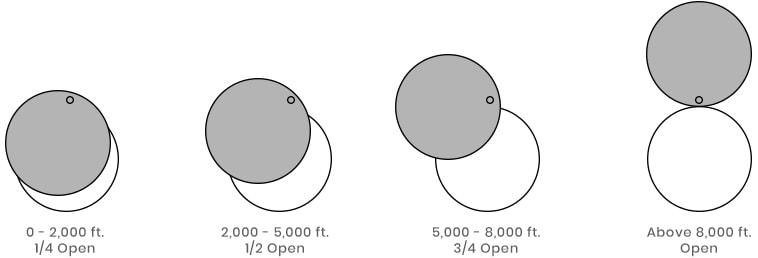
Based on my elevation, I would adjust my damper to be 1/4 open, as pictured above.
In terms of the exhaust, have both of the rebar inserted to help with temperature stabilization.
Charcoal
With PBC brisket what I do is fill about 1/2 basket.
I’ll then put around 1/4 chimney worth of charcoal, light it, then put a few lit coals on the unlit charcoal.
Putting the Brisket on the PBC
Add a chunk of post oak or similar hardwood to the lit coals.
Then put the brisket on the grates, fat side DOWN because that’s where the heat source is, directly below the brisket.
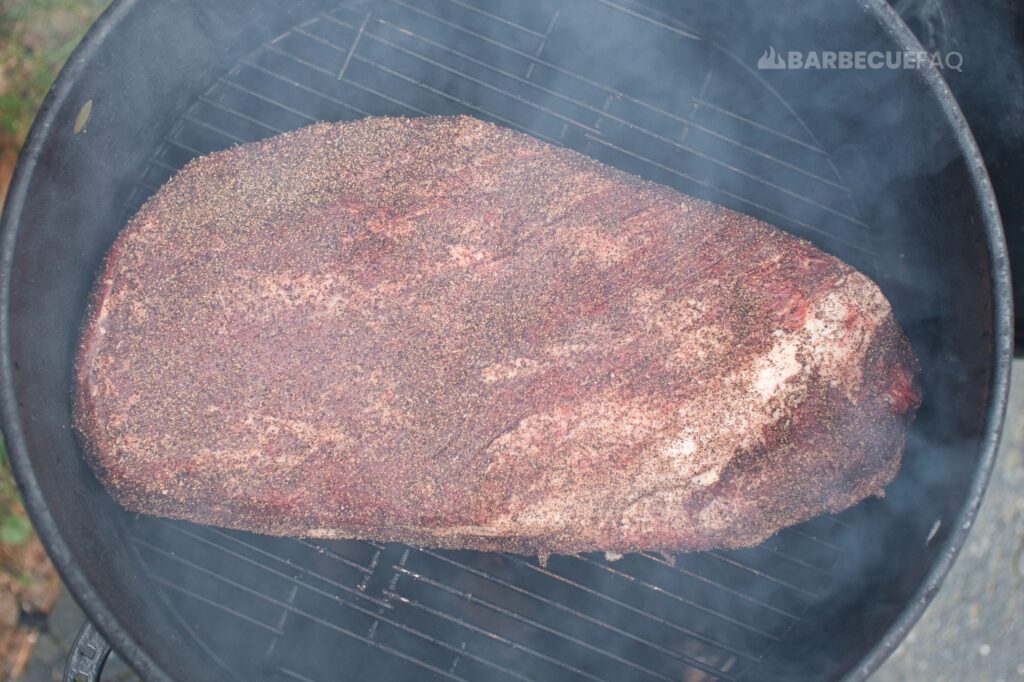
Rotating the Brisket
Every 30-45 minutes or so I’m rotating the brisket 90 degrees-ish.
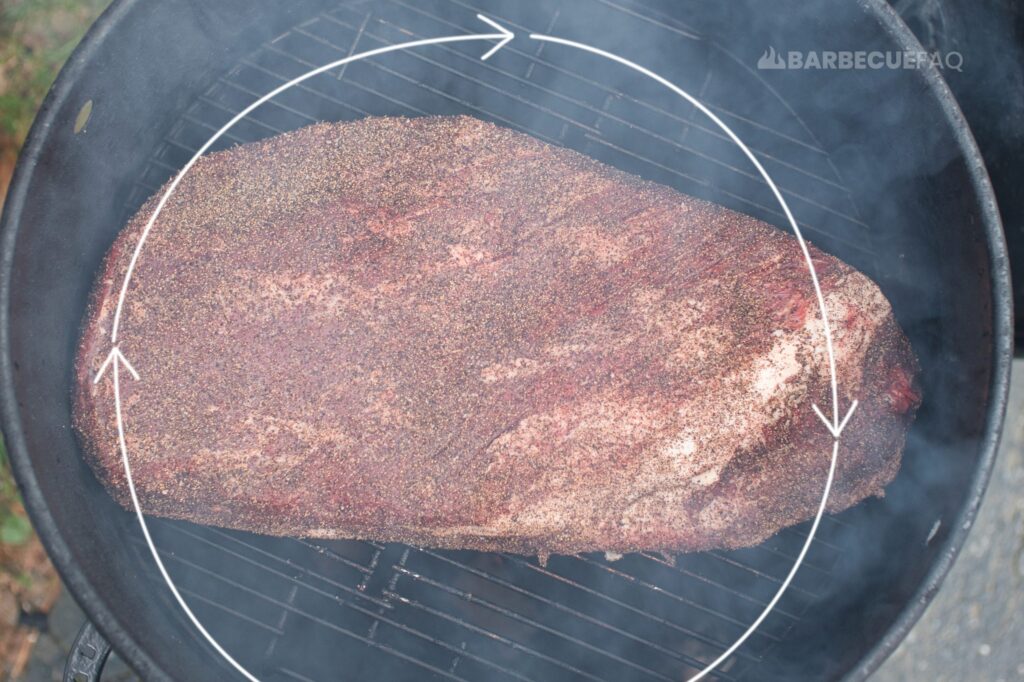
This is to help avoid things like hot spots that tend to happen on the PBC.
During this time is when I tend to add more wood chunks; Usually a wood chunk will last around 45-60 minutes which happens to line up with rotating the brisket.
Wrapping the Brisket
Wrap when the thickest part of the flat reaches 175-180F or when you’re happy with the bark.
Here’s the brisket when I wrapped:
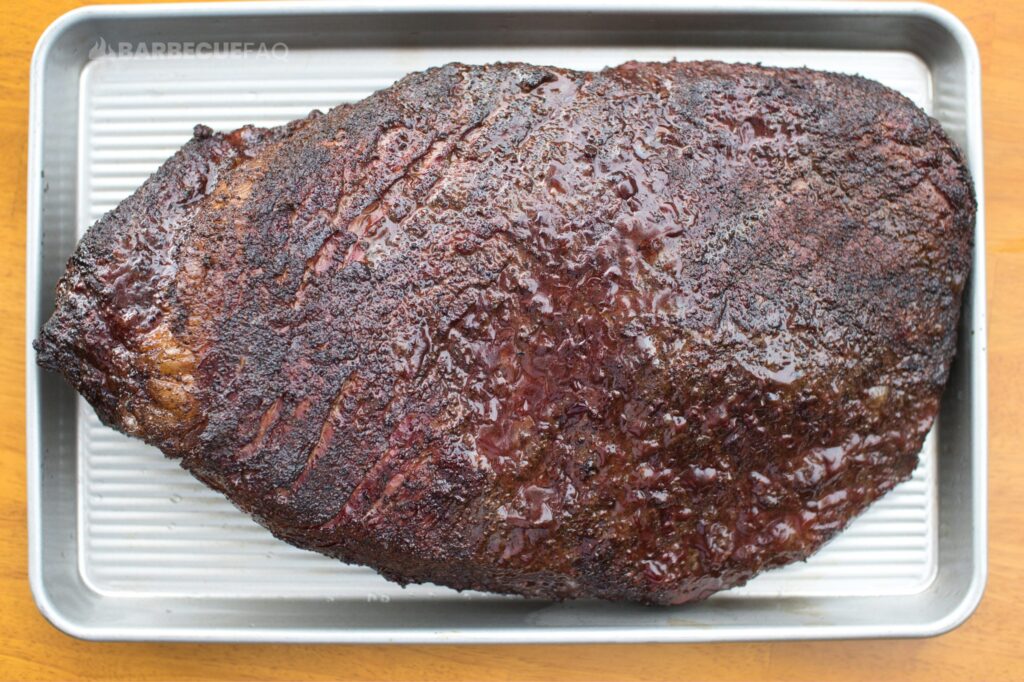
Wrap the brisket tight with foil or butcher paper and return to the smoker, fat side up in the wrap.
Checking for Tenderness
With a probe thermometer or a tooth pick, you can start poking the meat.
As you slide the probe in and out of the meat, it should feel like you’re sliding it through a jar of peanut butter or warm butter.
Typically brisket will reach tenderness at around 190-205F internal.
Once you reach tenderness, you need to rest the brisket.
Resting the Brisket
This process of resting from a finishing temperature of around ~200F down to ~160F takes ~2 hours.
What I like to do is leave the brisket wrapped and pop it into my oven (while turned off); Set a timer for 2 hours and wait.

Slicing the Brisket
After resting the brisket for 2 hours, you can slice the meat.
If you don’t know how to slice against the grain, read this article.
Remember, the point and the flat have grains that run in opposite directions!
From there you can serve and enjoy!
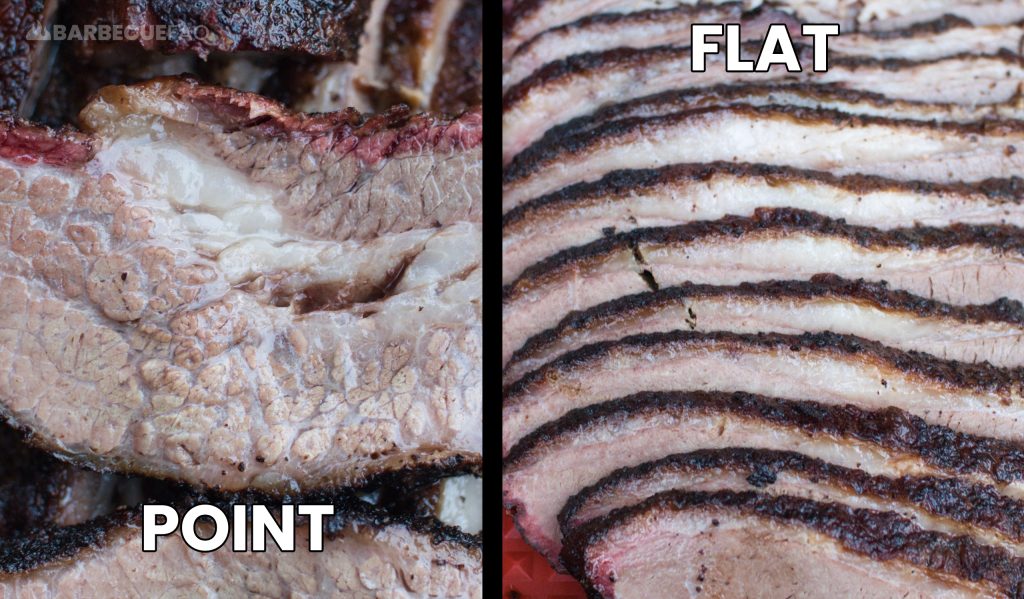
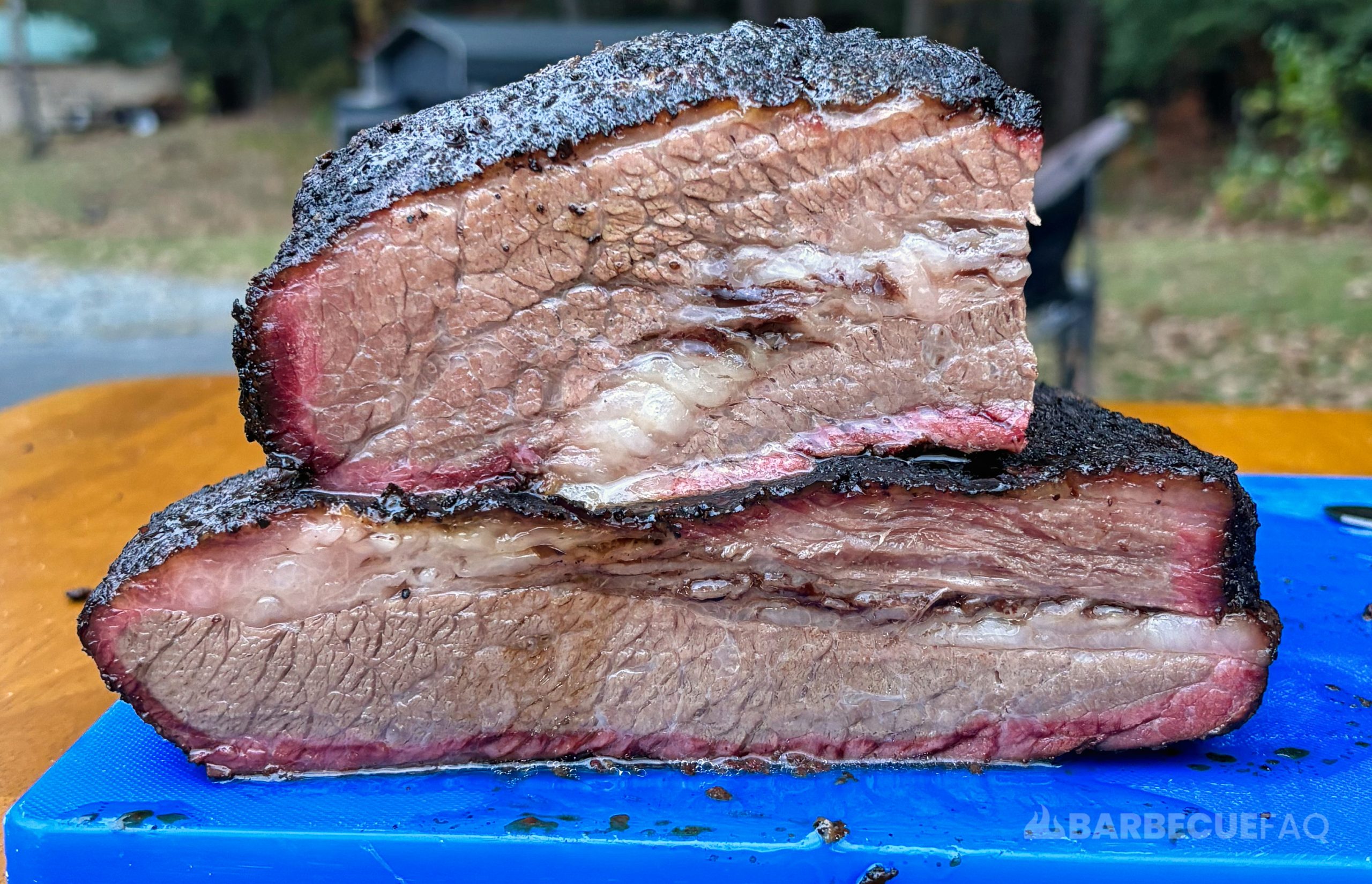
Pit Barrel Cooker Brisket
Ingredients
- Your Favorite Brisket Rub I used Steve Gow's from Smoke Trails BBQ
- 10 lb Beef Brisket
Instructions
- Trim brisket by sizing brisket to the pit barrel cooker. Trim the fat cap to roughly 1/4". Round edges of brisket to make more aerodynamic.
- Season all sides of the brisket with your favorite rub. If you don't have a brisket rub, use this rub recipe: 1 Tablespoon 16 Mesh Black Pepper on both sides. 1 Tablespoon Diamond Crystal Kosher salt on both sides. 1 Tablespoon Lawry's Seasoned salt on both sides.
- Setup your PBC by adjusting your intake vent based on your elevation. Use this link to approximate your elevation.
- Fill the charcoal basket half way. Remove 1/4 of this charcoal and light it.Add the lit charcoal back to the basket, spread out 4-5 wood chunks on the charcoal (I used cherry and pecan), put the grates back on the PBC, and then put the brisket on the PBC. Put your rebar through their respective slots. Cover the PBC with the lid.
- Every 30-45 minutes, rotate the brisket 90 degrees clockwise. Take brisket off the smoker at 175F internal or when you're happy with the bark.
- Tightly wrap in aluminum foil and return back to the PBC.
- Wait until the brisket is tender. With a toothpick or your probe thermometer, probe the entire brisket. The poke should slide in and out of the meat like warm butter or like through a jar of peanut butter. You should feel this sensation throughout the brisket.
- Once tender, take off the PBC and put the wrapped brisket in your oven for 2 hours.
- After resting, take out of the wrap, slice against the grain and enjoy!


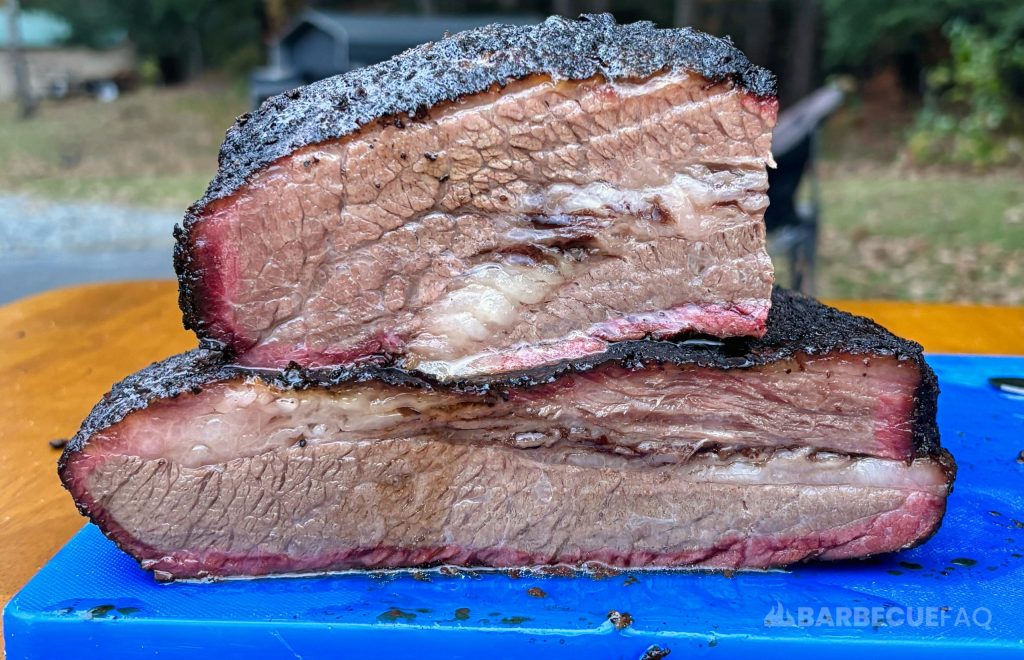



6 comments
Sam
Dylan, do you have an email so that I don’t have to keep blowing up your comments?
Thanks,
Sam
Dylan Clay
Hi Sam!
Shoot me an email over at Dylan@barbecuefaq.com – I try to check it daily.
-Dylan
Sam
Thank you. And that was an outstanding video.
I just checked, mine is 15.5 pounds prior to trimming, it is choice grade. Help me work this timeline backwards. If I want to serve at 3pm, I probably need to start resting at noon? Which means I should expect a stall from 8-11am? So I should start around midnight?
Hopefully I don’t have to bother you anymore. Outstanding site you have here.
Dylan Clay
No trouble at all – happy to help in any way that I can. Hopefully I’m getting back to you in a timely manner. Smoking brisket is always stressful, that’s why I do it a day in advance and then hot hold overnight these days.
So 15.5 lbs, assuming you’re doing a regular trim to a 1/4″ fat cap and evening out the flat and we’re going low and slow – that’s probably 12-13 lbs trimmed.
In most cases @ 225-250F you’ll see cook times of like 1-1.25 hrs per lb. So 12 lbs = 12-15 hours @ 225 or 9-12 hrs @ 250F.
(All my briskets I buy are 12-13 lbs and I trim down to around 9-10 lbs).
In almost every case I’m smoking the meat for 6 hours or until around ~175F in the thickest part of the flat.
The bark is set, it’s taken on a good amount of smoke, and likely looks like a meteorite. The fat cap also likely feels squishy like a marshmallow. If you take a piece in the fingers and tear it, underneath it’ll look yellow hued and caramelized.
Once I hit 175-180F I’m boating in 2 sheets of heavy duty aluminum foil and then popping into my electric smoker to finish.
Technically, heat is heat and your brisket has no idea what it’s being cooked by. I’m not super big on wasting charcoal when electricity is so cheap. You could technically do the same in your kitchen oven (set to 250-275F) or just do everything in the OKJ.
From here you’re just trying to get to 195-205F internal – the probe should glide in and out of the meat with ZERO effort – focus on the flat here as the point will come to tenderness faster.
Once done, leave in the boat and cover with another sheet of foil. Put into a cooler or into your oven while off for ~2 hours and rest down to ~160F internal to slice.
—-
So doing that backwards, you want to eat @ 3 pm.
Resting on the counter/oven from 203F > 160F while wrapped is 2-ish hours.
So we’re at 1 pm.
In the foil boat it will likely take 3-4 hours to go from 175F > 203-205F (typical tenderness temperatures) – assuming the worst @ 4 hours.
That puts us at 9 am.
Assuming 6 hours is what you intend to do smoke-wise and how long it takes to reach 170-180F.
That puts us at 3 am.
Charcoal with firestarters take 15 mins to light – which is how long my coffee takes to brew 🙂
So 2:45 am wake-up.
But that’s assuming the stall doesn’t last super long – all briskets are different, you could maybe pad an hour in there to account for that so 1:30 am wake-up.
You could opt for around midnight though and then just use a cooler or something to slowly bring down the internal temperature.
Hope that helps!
Sam
Dylan, if I am going to do a brisket (moderately sized, not enormous) on my OKJ Bronco (barrel style), and I want to do it the slower traditional way, how will that differ from what you have here? What techniques, times, etc will be different? Does a water pan take it from hot and fast to low and slow?
I assume it is still fat cap down because it is a barrel style, but beyond that I’m not sure how to adapt. Still do a foil boat beginning at 170 with fat cap up?
Thank you.
Dylan Clay
Hey Sam!
So that’s absolutely possible on the OKJ – mainly because it has a way to adjust intake and exhaust. The PBC runs hot and fast no matter what, it also doesn’t have sections for things like a water/drip pan or heat deflector so the bottom heat is quite strong.
If you can, definitely use the heat deflector/water pans; The water pan will help to function as a heat sink and also add humidity to smoker – just be sure to re-add water as you go. .
Aaron Palmer has a wonderful video that I remembered watching a bit ago: https://www.youtube.com/watch?v=gG65TyGFuTk – I believe he uses the OKJ Bronco; I’d definitely give that a watch.
If you do have the deflector like Aaron has here, I’d likely just go fat cap up the whole time since the fat doesn’t have a way to SEE the heat source and it’s also not dripping fat onto the fire which spikes temperature.
In Aaron’s video he didn’t wrap at all and just used the foil when he rested. But you could absolutely use a foil boat.
When boating too, always do fat cap up because that’s the whole point, it leaves the fat exposed the whole time so you can continue rendering it. The point in going to 170F is because we’re trying to push moisture out and exit the stall. If you foil boat during the stall you’ll collect too much liquid and you’ll braise the meat which sort of tastes more pot-roasty instead of “brisket-y.”
Hope the above helps in some way!
-Dylan